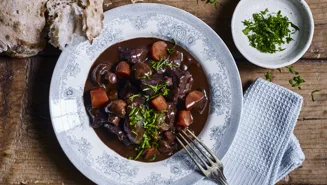
A lactose-free milk drink is, as the name suggests, milk that does not contain lactose. It has had its lactose removed through a specialised process. Lactose is a type of sugar found in milk from all mammals including cows, goats, sheep, and buffalo. This means that other dairy products such as cream, yoghurt, butter, and cheese also contain lactose.
How are lactose-free milk and milk drinks made?
Generally, the production of lactose-free milk involves an enzymatic treatment, where an enzyme called lactase is added to the milk. This enzyme naturally breaks down lactose into simpler sugars called glucose and galactose. If any other process is used, it is no longer a lactose-free milk, but a lactose-free milk drink.
At Arla, we employ a unique two-step process, which includes a filtering step before adding lactase.
The fresh milk is passed through specialised ultrafiltration filters, removing about half of the lactose. This filtering step is essential as hydrolysing the full amount of lactose would result in a much sweeter flavour profile.
After filtering, lactase is added to break down the remaining lactose.
The milk drink is then heat-treated like regular milk to ensure safety.
At Arla, we offer Extended Shelf Life (ESL) milk drinks with a fresh taste and varying shelf life, depending on the pasteurisation level. High-pasteurised products last 28-42 days when they are stored cool, while 'fresh' milk drinks last 7-9 days. Additionally, we have UHT lactose-free options available, which can be stored ambiently for several months.
Is lactose-free milk gluten-free?
Yes, lactose-free milk, and dairy in general, is gluten-free. Gluten is a type of protein found in grains. This means you will find gluten in wheat, rye, barley, and triticale (a hybrid grain that is a cross between wheat and rye). Where you will not find it, though, is in milk. Even if the cows or other mammals producing it have eaten gluten-containing grains, the gluten does not pass through into their milk.
If you want to know more about dairy and lactose, you can check out our article ‘Is lactose-free milk dairy-free?’.
Does lactose-free milk have calcium?
Removing lactose from milk does not significantly affect the amount of naturally occurring calcium, although some of it disappears during filtration.
Different types of lactose-free milk drinks
You will typically be able to buy any type of milk as a lactose-free milk or milk drink alternative. This gives you a lot of different options to choose from, depending on which type you enjoy the most or like using for cooking and baking.
We hope our brief overview below can inspire you to try different ones to find your favourites.
Fresh lactose-free skimmed milk drink
A popular choice is a lactose-free skimmed milk drink. This type is great for pouring onto breakfast cereals, into hot drinks like tea and coffee, and making smoothies, protein shakes, and baked goods.
It has a pale, white appearance and typically appears thinner in consistency than other milk types. In addition, it has a mild, lighter taste compared to other milk types. In terms of texture, it is less creamy and rich compared to other kinds of dairy products. However, this also means that it can make for a more refreshing drink.
Lactose-free semi-skimmed milk drink for everyday use
If you are looking for something a little creamier, a lactose-free semi-skimmed milk drink could be a match for you. This type has a thicker consistency compared to a skimmed lactose-free milk drink and a slightly richer and creamier flavour as well.
It offers a cross between the lighter taste of skimmed milk and the fullness of whole milk, making it a popular choice. It is versatile and can be used in a variety of ways such as drinking on its own, pouring over cereal, cooking, and baking.
Enhance your food with lactose-free whole milk drinks
Lactose-free whole milk drink is, of course, also an option. This type is preferred by those who desire the rich and creamy flavour and texture of full-fat dairy. Its fuller mouthfeel can enhance the creaminess in, for example, soups, puddings, custards, and sauces.
Lactose-free whole milk drink has a rich and creamy taste and offers an indulgent flavour profile with a pronounced dairy taste.
Try great-tasting lactose-free buttermilk
Buttermilk is a slightly thicker fermented dairy product. Its taste is tangy and distinctive, with pleasant acidity. Sometimes, it is even used as a refreshing beverage on its own.
It is also used in cooking and baking, adding a unique flavour and acidity to recipes such as pancakes, biscuits, marinades, and salad dressings. Get to know more about whether buttermilk is lactose-free.
Lactose-free milk drinks from goats and sheep
If you generally enjoy earthy undertones, lactose-free goat's milk and lactose-free sheep's milk will both be good choices for you. The former is known for its characteristic creamy consistency and tangy flavour. The latter is also creamy and rich in texture and known for its robust flavour. It is often described as being slightly sweet and having more depth of taste compared to cow’s milk but as being less earthy than that from goats.
The flavour and the looks
The process of removing and breaking down lactose into simpler sugar does not affect the visual characteristics. So, you cannot differentiate between regular and lactose-free milk or milk drinks this way – they all have a white or off-white colour and a generally uniform texture.
While it is generally not possible to distinguish lactose-free milk or milk drinks from the regular kind by sight alone, there are some flavour differences, so you may be able to taste which is which.
When lactose is broken down into glucose and galactose, the overall flavour of the dairy product changes slightly because these sugars are sweeter than lactose. However, the difference in sweetness between the two types is subtle, so you may not be able to tell the difference.







































